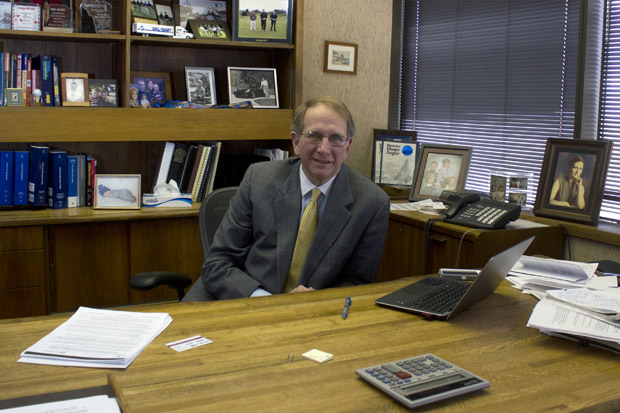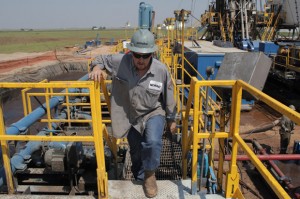
Don Millican, the Chief Financial Officer of Kaiser-Francis Oil Company.
Joe Wertz / StateImpact Oklahoma


Don Millican, the Chief Financial Officer of Kaiser-Francis Oil Company.
Joe Wertz / StateImpact Oklahoma

Joe Wertz / StateImpact Oklahoma
Don Millican, the Chief Financial Officer of Kaiser-Francis Oil Company.
The Kaiser-Francis Oil Company has a lot in common with other storied Oklahoma energy empires. The company has by-the-bootstrap entrepreneurial origins, it’s been battered by boom and bust, and it’s helmed by a billionaire CEO who has weathered controversy and been showered with praise.
But the Tulsa-based exploration and production company is unique in one surprising way: It isn’t pushing for oil and gas tax cuts.
Kaiser-Francis CFO Don Millican also doesn’t think the state tax credit for horizontal drilling actually increases in-state drilling.
“Severance tax rates never make a difference in that decision. They just don’t,” Millican says. “People are drilling where the hydrocarbons are. Where the hydrocarbons are, in sufficient quantities, it makes sense to drill.”

Joe Wertz / StateImpact Oklahoma
Toolpusher and rig manager Darrin Silcot walks the perimeter of a Triad Energy horizontal drilling operation near Alva, Okla. The company's CEO, Mike McDonald, says the tax incentive for horizontal drilling has led to more drilling at his company and others.
A temporary tax break for horizontal drilling expires in 2015, and the looming deadline has spurred state lawmakers to re-evaluate overall taxes on oil and gas production.
The tax incentive for horizontal drilling was put in place in the mid-‘90s, when the technique was new and experimental. For the first 48 months of production, qualifying drillers get a tax discount on the oil and gas that comes out of the ground: They pay 1 percent instead of 7 percent.
These days, almost all new wells in Oklahoma are drilled horizontally, so the cost of the incentive has ballooned alongside the state’s oil boom. It cost almost $150 million last year, which is more than seven times the combined appropriation for the two primary state agencies that regulate the industry. Some estimates project the tax incentive could grow to hundreds of millions a year.
Complicating matters, Oklahoma lawmakers in 2010 approved a measure delaying payments of drilling incentives for horizontal and deep wells. The deferred payments resumed in fiscal year 2013 and continue through 2015.
Former House Speaker T.W. Shannon, R-Lawton, proposed making permanent the horizontal drilling tax incentive. Shannon’s bill stalled, but Senate President Pro Tempore Brian Bingman on March 13 told Capitol reporters the conversation is ongoing, and that tax cut might happen this session.
“It could wait until next session, too, but again I think we just need to take a temperature reading in the industry and let’s sit down and have a decent discussion and see where we are,” says Bingman, R-Sapulpa.
Incentive or ‘Benefit?’
Oklahoma’s oil and gas industry is pushing to cut oil and gas taxes, and some lawmakers say low gross production taxes make the state more competitive by attracting drilling activity. State Sen. John Sparks, D-Norman, outlined the worry of the tax rate returning to 7 percent in a March 21 editorial in The Journal Record:
With current annual drilling expenditures already at $12 billion in Oklahoma, eliminating the horizontal drilling tax incentive as proposed by a small faction at the state Capitol would trigger a series of negative economic outcomes. Potential effects of raising taxes include a decline in oil and gas production, reduced royalty owner income, and a loss of jobs to neighboring states.
Millican says state incentives and tax cuts might mean more profit for an oil company, but the Kaiser-Francis CFO says gross production taxes have little effect on where, geographically, an oil company decides to drill.
“I guess the best evidence of that is the drilling boom that’s taking place in North Dakota, where they have an 11.5 percent severance tax,” he says. “A 3 percent difference is not going to make the decision whether or not you drill in a given location.”
Naturally, companies enjoying increased profits use those revenues to expand and grow, and pass money on to employees and shareholders, Millican says.
“It certainly is a benefit to the oil and gas industry to receive that reduced rate, but it isn’t causing a particular behavior,” he says. “And if you’re going to have an incentive, it seems like it ought to cause a change in behavior.”
Kaiser-Francis Oil is a private company that has one primary shareholder: billionaire CEO George Kaiser. Millican says his peers at large, publicly traded oil companies with out-of-state shareholders are likely under pressure to take advantage of every opportunity to make more money.
Raymond James energy analyst Andrew Coleman agrees.
“It makes perfect sense to lobby for any opportunity that kind of helps at the margins,” he says. “But the bigger driver is what [is] the overall commodity price environment?”
Millican says there’s another reason he’s not pushing for state oil and gas tax cuts: It’s one of the few taxes Oklahoma oil companies actually pay.
“The energy industry doesn’t pay a lot of income tax because of the intangible drilling cost deduction,” Millican says. “And we don’t have an ad valorem tax on oil and gas wells, like Texas does. So what is going to be their contribution to the running of the state? Severance taxes, historically, has been how the oil and gas industry has helped contribute their part to the state. And as corporate citizens, they ought to be contributing their part.”
Correction and clarification: The horizontal drilling tax credit expires in 2015 not 2014, as previously reported. And state Rep. T.W. Shannon’s proposal was to make permanent the 1 percent severance tax rate for horizontal drilling, not to reduce the severance tax rate to 1 percent.